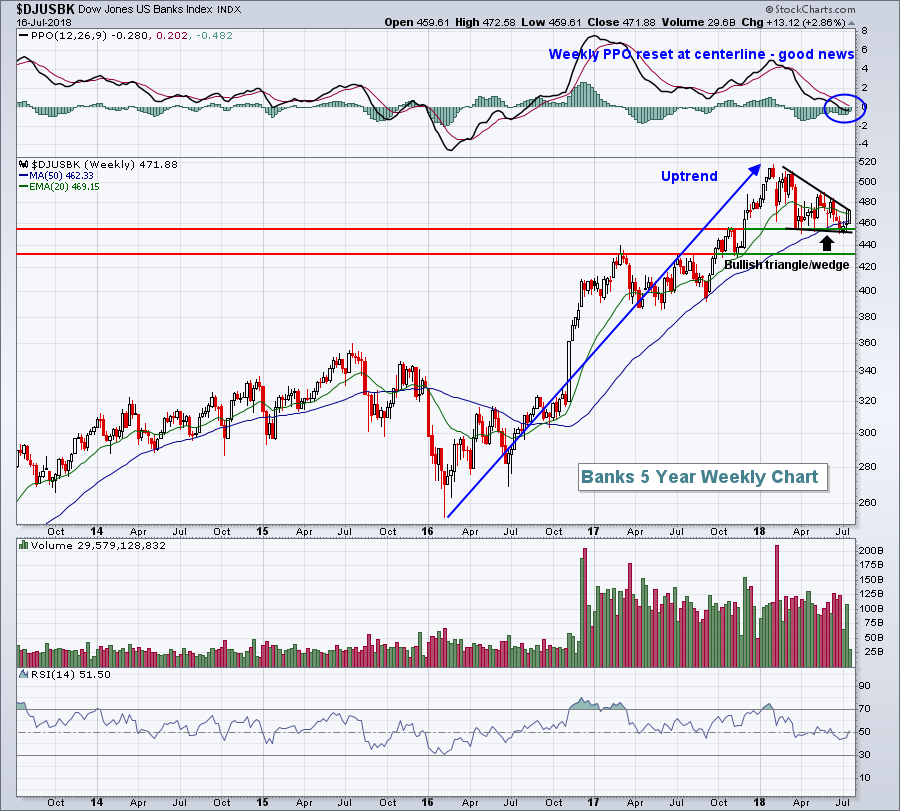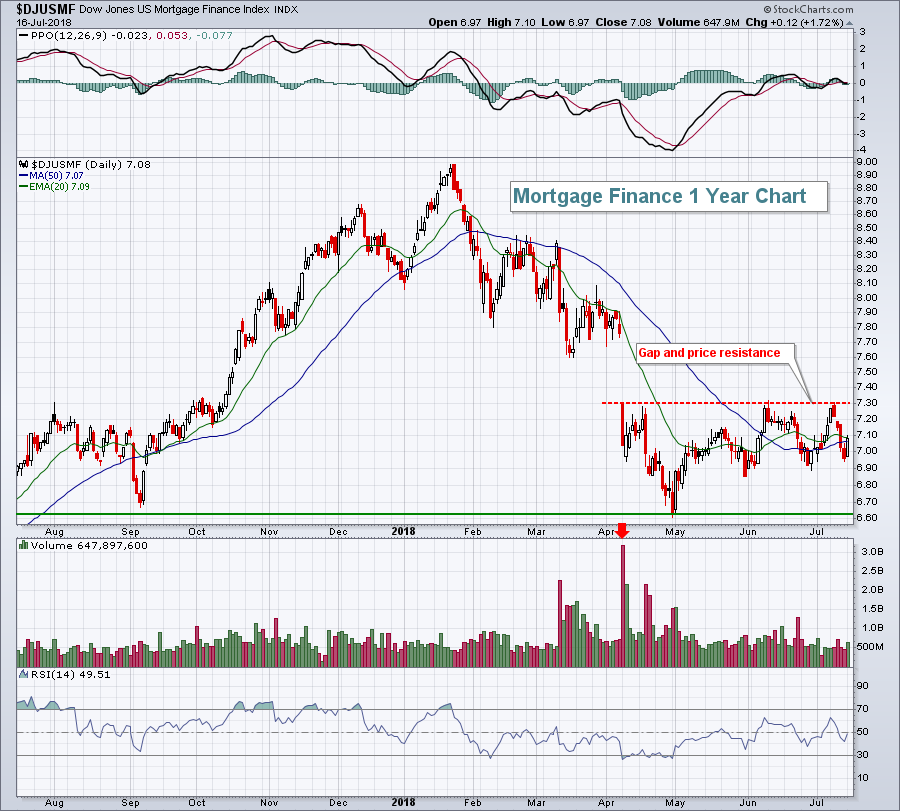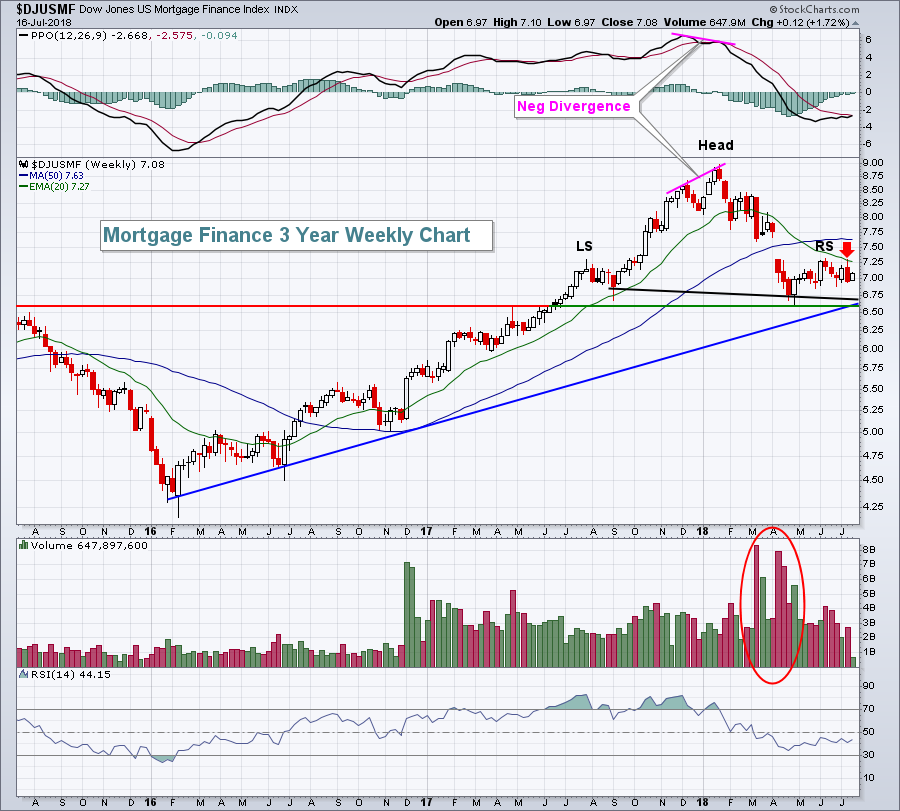Market Recap for Monday, July 16, 2018
The Dow Jones saw buying late in Monday's session, pushing this index of giants into positive territory. Leadership was clear. Large money center banks performed well and JP MorganChase (JPM) was easily the best perfoming Dow Jones stock, gaining nearly 4%. On the S&P 500, banks dominated as well with 5 of the top 8 performing S&P 500 stocks in the banking space, led by Bank of America (BAC), JPM, and Citigroup (C). Banks have done a nice job of holding key price support and now are challenging overhead resistance in a bullish continuation pattern. I've provided a more in-depth look at banks in the Sector/Industry Watch section below.
Given the overwhelming strength in banks, financials (XLF, +1.78%) dominated the sector leaderboard. Consumer discretionary (XLY, +0.25%) was the only other sector to finish in positive territory as clothing & accessories ($DJUSCF, +1.92%) rebounded amidst an upgrade for VFCorp (VFC) and strength in a number of component stocks that recently reported excellent quarterly results including G-III Apparel Group (GIII), Vera Bradley (VRA) and Polo Ralph Lauren (RL). The DJUSCF is nearing another breakout:
 I'd consider the short-term trading range to be 341-363. It's also worth noting that the all-time high in the DJUSCF was in April 2015 at 372.90. So if the DJUSCF does make a short-term breakout, it will still face significant overhead price resistance.
I'd consider the short-term trading range to be 341-363. It's also worth noting that the all-time high in the DJUSCF was in April 2015 at 372.90. So if the DJUSCF does make a short-term breakout, it will still face significant overhead price resistance.
Energy (XLE, -1.15%) was the weakest sector on Monday, damaged by rapidly declining crude oil prices ($WTIC). Crude oil fell nearly $3 per barrel yesterday. After falling more than $3 per barrel last Wednesday, it finally took a toll on the XLE. Solid support on the WTIC now resides at $64 per barrel. Energy bulls do not want to lose that support level.
Pre-Market Action
The big news this morning is Netflix (NFLX). Shares are plunging after they failed to meet revenue and subscriber projections. They also lowered Q3 guidance moving forward and that has spooked traders. In the end, I believe this provides an opportunity for entry for those in the long-term camp. From a short-term perspective, let's see how NFLX trades after the open. It looks like NFLX will open somewhere near its rising 20 week EMA, its first such test of 2018. Is it an opportunity? We'll soon find out.
Crude oil ($WTIC) is bouncing very mildly after a very rough session on Monday where the price of crude fell more than 4%. Gold ($GOLD) is meandering near a key short-term price support at $1240 per ounce. The 10 year treasury yield ($TNX) attempted to break above its declining 20 day EMA on Monday, but failed again. It trades this morning down 1 basis point to 2.85%.
U.S. futures are weak this morning, no doubt stunned by the NFLX miss and lower guidance. Obviously, the NASDAQ is likely to be under greater pressure as NFLX is a major component. The consumer discretionary ETF (XLY) is trading nearly 1% lower in pre-market action.
Current Outlook
Banks ($DJUSBK) are an important piece of the market puzzle. After a mixed reaction to a slew of bank earnings reports on Friday, the DJUSBK surged yesterday and cleared an important short-term price hurdle. The group has held solid price support in the 450-455 range and looks to break the triangle/wedge pattern that's bound it since January:
 Bank bulls have been under pressure throughout most of 2018, but after the DJUSBK surge on Monday, the bulls now have the upper hand and will try to break the index above key triangle/wedge resistance.
Bank bulls have been under pressure throughout most of 2018, but after the DJUSBK surge on Monday, the bulls now have the upper hand and will try to break the index above key triangle/wedge resistance.
Sector/Industry Watch
Mortgage finance ($DJUSMF) bounced 1.72% yesterday, but remains the worst performing industry group within financials over the past week. The group is mired in a bear flag formation that typically results in further downside action:
 The weekly picture provides a bit of hope, but there are plenty of negatives here as well:
The weekly picture provides a bit of hope, but there are plenty of negatives here as well:
 There was a weekly negative divergence at the January high and a potential topping head & shoulders pattern is in play here. A breakdown beneath the 6.50 level triggers significant downside potential from this H&S pattern. It also would break price support from the April price low and break trendline support from the past 2 1/2 years. Note the failure at the declining 20 week EMA (red arrow). I believe the April gap lower on massive volume changed the character of this chart. I'd be bearish mortgage finance until proven wrong.
There was a weekly negative divergence at the January high and a potential topping head & shoulders pattern is in play here. A breakdown beneath the 6.50 level triggers significant downside potential from this H&S pattern. It also would break price support from the April price low and break trendline support from the past 2 1/2 years. Note the failure at the declining 20 week EMA (red arrow). I believe the April gap lower on massive volume changed the character of this chart. I'd be bearish mortgage finance until proven wrong.
Historical Tendencies
After today's close, history turns against the bulls for one week. The July 18th through 24th period is among the worst two or three weeks of the year and begins what I consider to be the worst historical period of the year, which ends on September 26th. But let's focus for now on the upcoming week and the historical performance for each of the following indices:
S&P 500 (since 1950): -22.93%
NASDAQ (since 1971): -41.76%
Russell 2000 (since 1987): -48.88%
Key Earnings Reports
(actual vs. estimate):
CMA: 1.87 vs 1.62
GS: 5.98 vs 4.67
JNJ: 2.10 vs 2.06
OMC: 1.60 vs 1.54
PLD: .71 vs .71
SCHW: .58 (estimate - results not posted yet)
UNH: 3.14 vs 3.03
(reports after close, estimate provided):
AMX: .16
CSX: .86
FNF: .83
IBKR: .51
UAL: 3.07
Key Economic Reports
June industrial production to be released at 9:15am EST: +0.6% (estimate)
June capacity utilization to be released at 9:15am EST: 78.3% (estimate)
July housing market index to be released at 10:00am EST: 68 (estimate)
Happy trading!
Tom
